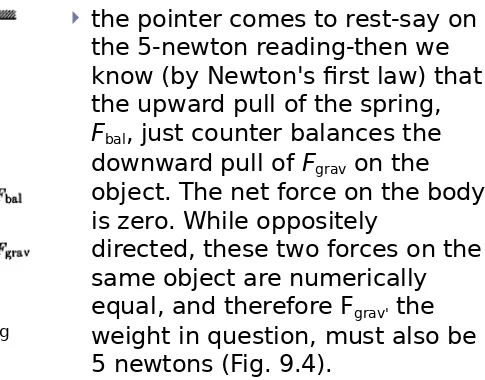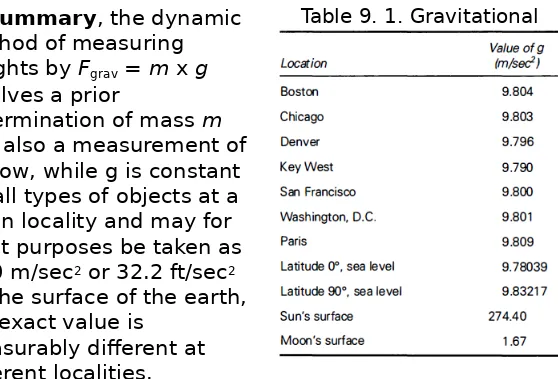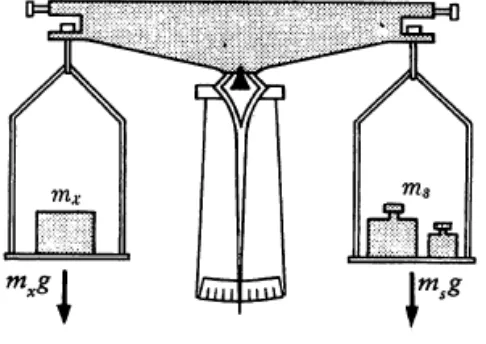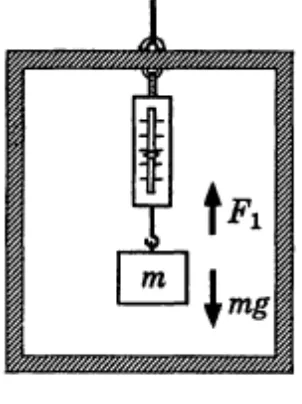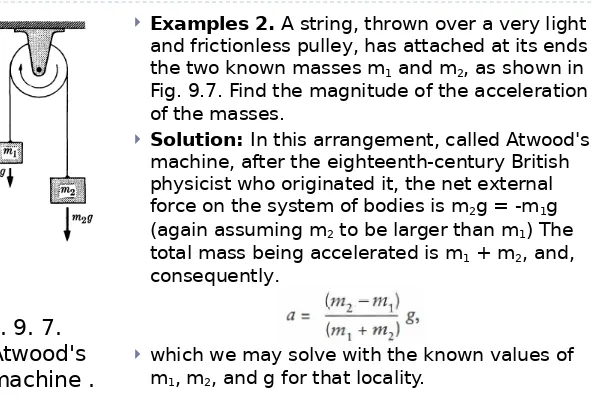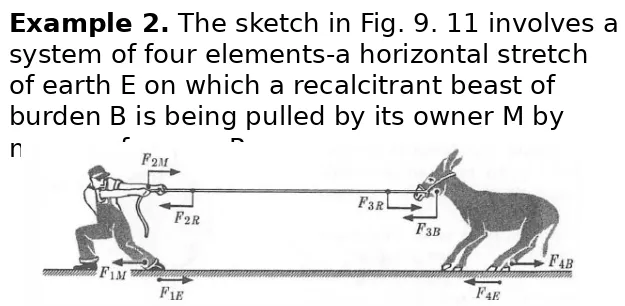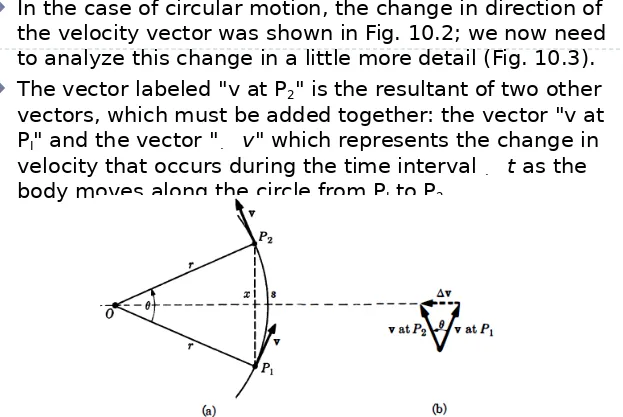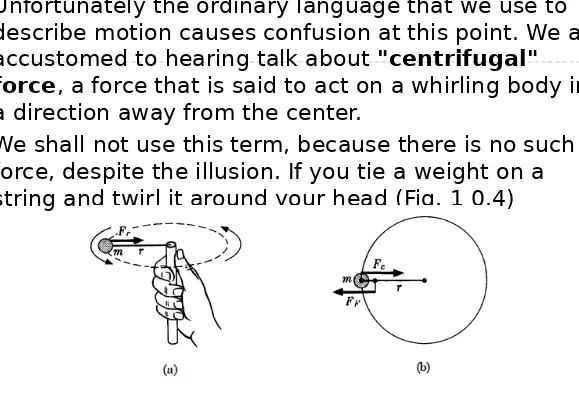PART C
Newton's Laws & His System of the World
9. Newton's Laws of Motion
10. Rotational Motion
11. Newton’s Law of Universal Gravitation
Newton's Laws and His System of the World
This subject of the formation of the
three laws of motion and of the law
of gravitation deserves critical
attention.
The whole development of thought
occupied exactly two generations.
It commenced with Galileo and
ended with
Newton's Principia
; and
Newton was born in the year that
Galileo died.
Also the lives of Descartes and
Huygens fall within the period
occupied by these great terminal
figures.
As we look into history, it seems that sometimes progress in
a field of learning depended on one person's incisive
formulation of the right problem at the right time. This is so
with the section of mechanics called dynamics, the science
that deals with the efects of forces on moving bodies.
The person was Isaac Newton, and the formulation was that
of the concepts force and mass, expounded in three
interconnected statements that have come to be called
Newton's three laws of motion.
But also, with the help of Newton's law of universal
Newton's Laws of Motion
9.1 Science in the 17
th
Century
Covering less than half of the 17th century and only the physical sciences, will show
the justification for the term "the century of genius" :
The work on vacuums and pneumatics by Torricelli, Pascal, von Guericke, Boyle, and Mariotte;
Descartes‘ great studies on analytical geometry and on optics;
Huygens' work in astronomy and on centripetal force, his perfection of the
pendulum clock, and his book on light;
The establishment of the laws of collisions by Wallis, Wren, and Huygens;
Newton's work on optics, including the interpretation of the solar spectrum, and his
invention of calculus almost simultaneously with Leibniz;
The opening of the famous Greenwich observatory; and Hooke's work, including that on elasticity.
One aspect is that both craftsmen and men of leisure
and money begin to turn to science, the one group
for improvement of methods and products and the
other for a new and exciting hobby-as amateurs (in
the original sense, as lovers of the subject).
But availability of money and time, the need for
science, and the presence of interest and
organizations do not alone explain or sustain such a
thriving enterprise.
Even more important ingredients are
able
9.2 A Short Sketch of Newton's Life
Isaac Newton was born on Christmas day in 1642, in the small village of
Woolsthorpe in Lincolnshire, England.
He was a quiet farm boy who, like young Galileo, loved to build and tinker with
mechanical gadgets and seemed to have a secret liking for mathematics.
Through the fortunate intervention of an uncle he was allowed to go to Trinity
College, Cambridge University, in 1661 (where he appears to have initially enrolled in the study of mathematics as applied to astrology!).
He proved an eager and excellent student. By 1666, at age 24, he had quietly
made spectacular discoveries in mathematics (binomial theorem, diferential calculus), optics (theory of colors), and mechanics.
Referring to this period, Newton once wrote:
And the same year I began to think of gravity extending to the orb of the Moon, and . . . from Kepler's Rule [third law] . . . I deduced that the forces which keep the Planets in their orbs must [be] reciprocally as the squares of their distances from the centers about which they revolve: and thereby compared the force requisite to keep the Moon in her orb with the force of gravity at the surface of the earth, and found them to answer pretty nearly. All this was in the two plague years of 1665 and 1666, for in those days I was in the prime of my age for invention, and pIinded Mathematics and Philosophy more than at any time since.
From his descriptions we may conclude that during those
years of the plague, having left Cambridge for the time to
study in isolation at his home in Woolsthorpe, Newton had
developed a clear idea of the first two laws of motion and
of the formula for centripetal acceleration, although he did
not announce the latter until many years after Huygens'
equivalent statement.
After his return to Cambridge, he did such creditable work
that he followed his teacher as professor of mathematics.
He lectured and contributed papers to the Royal Society,
at first particularly on optics. His Theory of Light and
Colors, when finally published, involved him in so long and
bitter a controversy with rivals that the shy and
Newton now concentrated most on an extension
of his early eforts in celestial mechanics the study
of planetary motions as a problem of physics.
In1684 the devoted friend Halley came to ask his
advice in a dispute with Wren and Hooke as to the
force that would have to act on a body executing
motion along an ellipse in accord with Kepler's
laws; Newton had some time before found the
rigorous solution to this problem ("and much other
matter") . Halley persuaded his reluctant friend to
publish the work, which touched on one of the
In less than two years of incredible labors the
Principia was ready for the printer; the
publication of the volume (divided into three
"Books") in 1687 established Newton almost
at once as one of the greatest thinkers in
history.
A few years afterward, Newton, who had
always been in delicate health, appears to
have had what we would now call a nervous
breakdown.
On recovering, and for the next 35 years until
his death in 1727, he made no major new
9.3 Newton's Principia
In the original preface to Newton's we find a clear outline:
Since the ancients considered mechanics to be of the greatest
importance in the investigation of nature and science, and since the
moderns have undertaken to reduce the phenomena of nature to
mathematical laws, it has seemed best in this treatise to concentrate
on mathematics as it relates to natural philosophy [we would say
"physical science"] . . .
For the basic problem of philosophy seems to be to discover the forces
What a prospect! The work begins with a set of definitions: in this case,
mass, momentum, inertia, force, and centripetal force. Then follows a
section on absolute and relative space, time, and motion.
Mass
Newton was very successful in using the concept of mass, but less so in
clarifying its meaning. He states that mass or "quantity of matter“ is "the product of density and bulk" (bulk = volume). But what is density? Later on in the
Principia, he defines density as the ratio of "inertia“ to bulk; yet at the beginning, he had defined inertia as proportional to mass.
Thus a modem text or encyclopedia typically states that mass is simply an
undefined concept that cannot be defined in terms of anything more
fundamental, but must be understood operationally as the entity that
relates two observable quantities, force and acceleration. Newton's second
law, to be introduced below, can be regarded as a definition of mass.
What is more important is that Newton clearly established the modem
distinction between mass and weight-the former being an inherent
Time.
Newton writes:
example, an hour, a day, a month, a year-is commonly used instead of true time.
Space.
Newton continues:
Absolute space, of its own nature without reference to anything external, always
remains homogeneous and immovable.
Relative space is any movable measure or dimension of this absolute space; such
a measure or dimension is determined by our senses from the situation of the space with respect to bodies . . .
Since these parts of space cannot be seen and cannot be distinguished from one
In the introductory section of the Principia, Newton stated
his famous three laws of motion and the principles of
composition of vectors (for example, of forces and of
velocities).
Book 1
, titled "
The Motion of Bodies
," applies
these laws to problems of interest in theoretical astronomy:
the determination of the orbit described by one
body around another, when they are assumed to interact
according to various force laws, and mathematical theorems
concerning the summation of gravitational forces exerted by
diferent parts of the same body on another body inside or
outside the first one.
Book 2
, on “
The motion of bodies
in resisting
mediums
”
Along with this there are a number of theorems and
Book 3
, "
The System of the World
," is the
culmination: It makes use of the general results
derived in Book 1 to explain the motions of the
planets and other gravitational phenomena such as
the tides. It begins with a remarkable passage on
"Rules of Reasoning in Philosophy."
The four rules, refecting the profound faith in the
uniformity of all nature, are intended to guide
scientists in making hypotheses, and in that function
they are still up to date.
The frst
has been called a
principle of parsimony, and
the second
and
third
,
principles of unity.
The fourth
is a faith without
Rule 1
No more causes of natural things should be admitted than are both true
and sufcient to explain their phenomena.
Rule 2
Therefore, the causes assigned to natural efects of the same kind must
be, so far as possible, the same.
Rule 3
Those qualities of bodies that cannot be intended and remitted [that is,
qualities that cannot be increased and diminished] and that belong to
all bodies on which experiments
can be made should be taken as qualities of all bodies universally.
Rule 4
In experimental philosophy. propositions gathered from phenomena
by induction should be considered exactly or very nearly true
9.4 Newton's First Law of Motion
We may phrase Newton's first law of motion, or
law of inertia
, as
follows:
Every material body persists in its state of rest or of
uniform, unaccelerated motion in a straight line, if and only if it
is not acted upon by a net (that is, unbalanced external) force
.
The essence is this: If you see a moving body deviating from a straight
line, or accelerating in any way, then you must assume that a net force
(of whatever kind) is acting on the body; here is the criterion for
recognizing qualitatively the presence of an unbalanced force.
There is implied only the definition of force as the "cause" of change of
velocity, a definition we already alluded to in our discussion of Galileo's
work. We recall that the Aristotelian scholastics had a rather diferent
view in this matter; they held that force was also the cause of uniform
(unaccelerated) motion.
It has been made plain that a net force must be supplied to change a
Problem 9. 1 .
Explain in terms of Newton's
first law of motion the common experience of
lurching forward when a moving train
suddenly decelerates and stops. Explain what
happens to the passengers in a car that
9.5 Newton's Second Law of Motion
In Newton's own formulation of the second law, he
states that
the force acting on a body is equal
to the change of its quantity of motion,
where "quantity of motion" (later called
"momentum ") is defned as the product of
mass and velocity.
It is customary to begin by stating the second law
of motion in the form:
The net (external
unbalanced) force acting on a material body
is directly proportional to, and in the same
direction as, its acceleration.
9.5 Newton's Second Law of Motion
The constant so defined is a measure of the
body's inertia, for clearly a large ratio of
F
netto
a means that a large force is needed to
produce a desired acceleration, which is just
what we expect to find true for large, bulky
objects
If we now symbolize the constant in Eq. (9.1 ),
the measure of inertia, by a letter of its own,
In summary:
Newton's second law, in
conjunction with the essentially arbitrary
choice of one standard of mass, conveniently
fixes the unit of force, permits the calibration
of balances, and gives us an operational
9.6 Standard of Mass
It will readily be appreciated that the Standard of Mass that represents 1
kilogram, though essentially arbitrary, has been chosen with care. For
scientific work, 1/1000 of 1 kilogram, equal to 1 gram, was originally
defined as the mass of a quantity of 1 cubic centimeter (1 cm
3) of distilled
water at 4°C. This decision, dating from the late eighteenth century, is
rather inconvenient in practice. Although standardizing on the basis of a
certain amount of water has the important advantage that it permits
cheap and easy reproduction of the standard anywhere on earth, there are
obvious experimental difculties owing to the efects of evaporation, the
additional inertia of the necessary containers, relatively poor accuracy for
measuring volumes, and so on.
Therefore, it became accepted custom to use as the standard of mass a
certain piece of precious metal, a cylinder of platinum alloy kept under
careful guard at the Bureau lnternationale des Poids et Mesures at Sevres,
a suburb of Paris (alongside what for a long time was defined as the
standard of length, a metal bar regarded as representing the distance of 1
meter) . For use elsewhere, accurate replicas of this international standard
of mass have been deposited at the various bureaus of standards
Fig. 9.3. Standard kilogram, a
platinum-iridium cylinder
constructed in 1878, held at
Sevres, France, together with a
standard mete r.
Again, it was a matter
of convenience and
accuracy to make this
metal block have an
inertia 1000 times
that of a I -g mass;
9.7 Weight
Objects can be acted on by all kinds of forces; by a push from the hand;
by the pull on a string or spring balance attached to the object; by a collision with another object;
by a magnetic attraction if the object is made of iron or other susceptible materials; by the action of electric charges;
by the gravitational attraction that the earth exerts on bodies.
But no matter what the origin or cause of the force, and no matter where in the
universe it happens, its efect is always given by the same equation, Fnet = ma.
Newton's second law is so powerful precisely because it is so general, and because we can apply it even though at this stage we may be completely at a loss to
understand exactly why and how a particular force (like magnetism or gravity) should act on a body.
If the net force is, in fact, of magnetic origin, we might write Fmag = ma; if electric, Fel = ma; and so forth.
Along the same line, we shall use the symbol Fgrav when the particular force involved
Presupposed throughout the previous paragraphs was
some accurate method for measuring
F
grav.We might
simply drop the object, allowing
F
gravto pull on the object
and to accelerate it in free fall, and then find the
magnitude of
F
gravby the relation.
Happily there is another method that is easier and more
direct. We need only our previously calibrated spring
balance; from it we hang the body for which
F
gravis to be
determined, and then wait until equilibrium is
established. Now we do not allow F
gravdownward to be
Fig. 9.4. Weighing
with a spring
balance.
the pointer comes to rest-say on
the 5-newton reading-then we
know (by Newton's first law) that
the upward pull of the spring,
F
bal, just counter balances the
downward pull of
F
gravon the
object. The net force on the body
is zero. While oppositely
directed, these two forces on the
same object are numerically
equal, and therefore F
grav'the
In summary
, the dynamic
method of measuring
weights by
F
grav=
m
x
g
involves a prior
determination of mass
m
and also a measurement of
g
. Now, while g is constant
for all types of objects at a
given locality and may for
most purposes be taken as
9.80 m/sec
2or 32.2 ft/sec
2on the surface of the earth,
the exact value is
measurably diferent at
diferent localities.
9.8 The Equal-Arm Balance
Before we leave the crucial-and initially perhaps
troublesome--concept of mass,
we must mention a third way of
measuring the mass of objects
, in everyday practice by far
the most favored and accurate method.
By way of review, recall first that we need the essentially
arbitrary standard. Once this has been generally agreed on,
we can calibrate a spring balance by using it to give the
standard measurable accelerations on a smooth horizontal
plane.
Then the calibrated balance can serve to determine other,
unknown masses, either :
(a) by a new observation of pull and resulting acceleration on the
horizontal plane, or
(b) by measuring on the balance
F
gravfor the object in question and
Fig. 9.5. Weighing
with an equal-arm
balance.
To methods (a) and (b) we now add method (c),
known of course as "weighing" on an equal arm balance-at first glance seemingly simple and straightforward, but in fact conceptually most deceptive.
We place the unknown mass mx on one pan (Fig.
9.5) and add a sufcient quantity of calibrated and marked auxiliary-standard masses on the other side to keep the beam horizontal.
When this point is reached, the gravitational pull
on the unknown mass, namely mx g, is
counterbalanced by the weight of the standards, m,g. (Note that we assume here the sufciently verified experimental result concerning the equality of gravitational accelerations for all masses at one locality. )
But if mxg = msg, then mx = ms. Counting up the
9.9 Inertial and Gravitational Mass
We see that case (a) on one hand and, (b) and (c) on the other measure two
entirely diferent attributes of matter, to which we may assign the terms inertial mass and gravitational mass, respectively.
For practical purposes we shall make little distinction between the two types of
mass. But in order to remind ourselves how essential and rewarding it may be to keep a clear notion of the operational significance of scientific concepts, and that, historically, considerable consequences may follow from a reconsideration of long-established facts in a new light, there are these words from Albert
Einstein's and Leopold Infeld's book The Evolution of Physics:
Is this identity of the two kinds of mass purely accidental, or does it have a deeper
significance? The answer, from the point of view of classical physics, is: the identity of the two masses is accidental and no deeper significance should be attached to it. The answer of modern physics is just the opposite: the identity of the two masses is
fundamental and forms a new and essential clue leading to a more profound
understanding. This was, in fact, one of the most important clues from which the so-called general theory of relativity was developed.
A mystery story seems inferior if it explains strange events as accidents . It is certainly
9.10 Examples and Applications of
Newton's Second Law of Motion
Examples 1.
An object of mass m (measured in kg)
hangs from a calibrated spring balance in an elevator
(Fig. 9 . 6 ) . The whole assembly moves upward with a
known acceleration a (measured in m/sec
2). What is the
reading on the balance?
Solution:
As long as the elevator is stationary, the
upward pull of the balance, and hence its reading
F
I,
will be equal in magnitude to the weight mg of the
object. The same is true if the elevator is moving up or
down with constant speed, which is also a condition of
equilibrium and of cancellation of all forces acting on
m
. However, in order to accelerate upward with
a
m/sec
2,
m
must be acted on by a net force of
ma
Fig. 9. 6. Weight of
an object suspended
in an elevator
so
The reading F
Iwill be larger
Fig. 9. 7.
Atwood's
machine .
Examples 2.
A string, thrown over a very light
and frictionless pulley, has attached at its ends
the two known masses m
1and m
2, as shown in
Fig. 9.7. Find the magnitude of the acceleration
of the masses.
Solution:
In this arrangement, called Atwood's
machine, after the eighteenth-century British
physicist who originated it, the net external
force on the system of bodies is m
2g = -m
1g
(again assuming m
2to be larger than m
1) The
total mass being accelerated is m
1+ m
2, and,
consequently,
which we may solve with the known values of
9.11 Newton's Third Law of Motion
Newton's frst law defined the force concept qualitatively, and the second law quantified the concept while at the same time providing a meaning for the idea of mass. To these, Newton added another highly original and important law of motion, the third law, which completes the general characterization of the concept of force by explaining, in essence, that each existing force on one body has its mirror-image twin on another body.
In Newton's words,
To any action there is always an opposite and equal reaction; in other words, the
actions of two bodies upon each other are always equal and always opposite in
direction: Whatever presses or draws something else is pressed or drawn just as much by it.
If anyone presses a stone with a finger, the finger is also pressed by the stone.
If a horse draws a stone tied to a rope, the horse will (so to speak) also be drawn back
equally towards the stone, for the rope, stretched out at both ends, will urge the horse toward the stone and the stone toward the horse by one and the same endeavor to go slack and will impede the forward motion of the one as much as it promotes the
forward motion of the other.
(Principia)
To emphasize all these points, we might rephrase the third law of motion as
follows: Whenever two bodies A and B interact so that body A
experiences a force (whether by contact, by gravity, by magnetic
9.12 Examples and Applications of Newton's
Third Law
Example 1. The simplest case concerns a box (body A)
standing on the earth (body B). Let us identify the forces that act on each. Probably the one that comes to mind first is the weight of the box, Fgrav' We name it here F1A and enter it as a
vertically downward arrow, "anchored" to the box A at its center of gravity (see Fig. 9.10a).
The reaction that must exist simultaneously with this pull of
the earth on the box is the pull of the box on the earth, equally large (by the third law) and entered as a vertical,
upward arrow, F1B at the center of the earth in Fig. 9.10b. This
completely fulfills the third law. However, as the second law informs us, if this were the complete scheme of force, the box should fall down while the earth accelerates up.
This is indeed what can and does happen while the box drops
to the earth, settles in the sand, or compresses the stones beneath it. In short, the two bodies do move toward each other until enough mutual elastic forces are built up to balance the previous set.
Specifically, the earth provides an upward push on the box at
the surface of contact, as shown in Fig. 9.10c by F2A an
upward arrow "attached" to the box, while, by the law now under discussion, there exists also an equal, oppositely directed force on the ground, indicated by F2B in Fig. 9.10d.
There are now two forces on each body.
Equilibrium is achieved by the equality in magnitude of
F
1Aand F
2Aon A, and by F
1Band F
2Bon B. But beware!
F
1Aand F
2Aare not to be interpreted as action and
reaction, nor are F
1Band F
2B.
The reaction to F
1Ais F
1B, and the reaction to F
2Ais F
2B.
Furthermore, F
1and F
2are by nature entirely diferent
sets of forces the one gravitational and the other
elastic.
In short, F
1Aand F
1Bare equally large by Newton's third
Example 2.
The sketch in Fig. 9. 11 involves a
system of four elements-a horizontal stretch
of earth E on which a recalcitrant beast of
burden B is being pulled by its owner M by
means of a rope R.
Follow these four force couples:
F
1Eis the push experienced by the earth,
communicated to it by the man's heels (essentially by static friction).
The reaction to
F
1Eis the equally large force
F
1Mexerted on the man by the
In equilibrium, the separate forces on each of the four objects balance; but
if equilibrium does not exist, if the man succeeds in increasing the donkey's
speed to the left, then
F
3B-
F
4B=
m
beastx
a
, and similarly for the other
members of the system.
And whether there is equilibrium or not, any "action" force is equal and
opposite to its " reaction."
The whole point may be phrased this way:
By the third law, the forces FIE and F1M are equal; similarly, F2M and F2R are equal. But the third law says nothing whatever about the relationship of F1M to F2M two
forces arranged to act on the same body by virtue of the man's decision to pull on a rope, not by any necessity or law of physics.
CHAPTER 10 : Rotational Motion
In the previous chapters we first acquainted ourselves with the
description of uniformly accelerated motions along a straight line, and in
particular with that historically so important case of free fall. Next came
general projectile motion, an example of motion in a plane considered
as the superposition of two simple motions. Then we turned to a
consideration of the forces needed to accelerate bodies along a straight
line.
But there exists in nature another type of behavior, not amenable to
discussion in the terms that we have used so far, and that is rotational
motion, the motion of an object in a plane and around a center, acted on
by a force that continually changes its direction of action.
This topic subsumes the movement of planets, fywheels, and
elementary particles in cyclotrons. We shall follow the same pattern as
before: concentrating on a simple case of this type, namely, circular
motion.
We shall first discuss the kinematics of rotation without regard to the
10.1 Kinematics of Uniform Circular Motion
Consider :
a point whirling with constant speed in a circular path about a center
O;
the point may be a spot on a record turntable, or
a place on our rotating globe, or,
to a good approximation, the planet Venus in its path round the sun.
Before we can investigate this motion, we must be able to
describe it. How shall we do so with economy and precision?
Some simple new concepts are needed:
a) The frequency of rotation
is the number of revolutions
made per second (letter symbol n), expressed in I/sec (or sec
-t).
A wheel that revolves 10 times per second therefore has a
frequency of
n
= 10 sec
-1While useful and necessary, the
b) Next, we define
the concept period of rotation
(symbol T) as
the number of seconds needed per complete revolution, exactly
the reciprocal of n, and expressed in units of seconds.
The wheel would consequently have a period of rotation of 0.1 sec.
c)
An angular
measure is required. The angle a swept through by a
point going from P
1to P
2(Fig. 10.1) can, of course, be measured in
degrees, but it is more convenient in many problems to express
by the defining equation
Fig. 10. 1. Definition of an angle
in radian measure:
=
s
/
r.
where
s
is the length of the arc
and r is the radius of the circle.
This ratio of arc to radius is a
d) We now inquire into
the
velocity of a particle
executing uniform circular
motion. The word "uniform"
means, of course, that the rate
of spin (the speed
s
/
t
) does not
change. Nevertheless, for
future reference, it is well to
remember that the velocity
vector associated with the
rotating point does change in
direction from one instant to
the next, although its
magnitude, represented by the
length of the arrows in Fig.
10.2, is here constant.
Let us now concentrate entirely on
the magnitude of the velocity, the speed, given again by the ratio of distance covered to time taken; if we know the period or frequency of the motion and the distance r from the spot to the center of the circle, v is directly found (usually in cm/sec) by realizing that s = 2 r if t = T, that is,
e) The quantity defined in this last
equation refers to the magnitude of the tangential or linear velocity, i.e., to the velocity of the point along the direction of its path. Analogous to this time rate of change of distance
stands the powerful concept angular velocity [symbolized by the Greek letter (omega)], which is the time
rate of change of angle. By definition, for the type of motion we are here considering,
If we happen to know
n
or
T
, we can find the
magnitude of the angular velocity from the
fact that
= 2
if
t
=
T
, or
The formal relation between
and
v
is
10.2 Centripetal Acceleration
In the previous section that motion with constant
speed around a circle implies that the velocity vector is
continually changing in direction though not in
magnitude.
According to Newton's laws of motion, a force must be
acting on a body whose velocity vector is changing in
any way, since if there were no net force it would
continue to move at constant velocity in a straight line.
And if there is a force, there must be an acceleration.
So when in circular motion with constant speed, a body
is in the seemingly paradoxical situation of being
In the case of circular motion, the change in direction of
the velocity vector was shown in Fig. 10.2; we now need
to analyze this change in a little more detail (Fig. 10.3).
The vector labeled "v at P
2" is the resultant of two other
vectors, which must be added together: the vector "v at
P
I" and the vector "
v
" which represents the change in
velocity that occurs during the time interval
t
as the
body moves along the circle from P
Ito P
2
As can be seen from the· diagram, the vector
v
is
directed toward the center of the circle. The acceleration
is defined as the change in velocity divided by the time
interval, in the limit as the time interval becomes very
small. In symbols:
Acceleration is also a vector, directed toward the center
of the circle; hence it is called the
centripetal
acceleration
("centripetal" means "seeking the center”)
.
The corresponding force that must be acting on the body
Unfortunately the ordinary language that we use to
describe motion causes confusion at this point. We are
accustomed to hearing talk about
"centrifugal"
force
, a force that is said to act on a whirling body in
a direction away from the center.
We shall not use this term, because there is no such
force, despite the illusion. If you tie a weight on a
string and twirl it around your head (Fig. 1 0.4)
You think you can feel such a force, but that is a force acting on you at
the center, not a force acting on the whirling body; it is in fact the
third-law reaction to the centripetal force acting on the whirling weight. Or, if
the string breaks, you see the object fying away along the tangent of
the circular path it was following just before the break. But no force pulls
it in fight (not counting gravity, downward) and it does not move of
along a radius either.
Isaac Newton was one of the first to recognize that all these phenomena
are
due to the natural tendency-inertia-of any body
to keep on
moving in the same direction if it is not constrained to do otherwise.
If the string breaks when the weight is at the point P
1(Fig. 10.3), it will
"fy of on a tangent" (not along the radius)that is, it will continue to
The result for the magnitude of the centripetal acceleration is
very simple:
Let us summarize its physical meaning by quoting Newton in
the Principia of 1687, a very clear discussion and one that
indicates how Newton was able to make connections between
a great variety of situations:
Centripetal force is the force by which bodies are drawn from all
sides, or are impelled, or in any way tend, toward a point as to a
center.
One force of this kind is gravity, by which bodies tend toward
the center of the earth;
another is magnetic force, by which iron seeks a lodestone;
and yet another is that force, whatever it may be, by which
10.3 Derivation of the Formula for Centripetal
Acceleration and Centripetal Force
In Fig. 10.3, a point moves uniformly through an angle
from P
1to P
2along the arc
s
.
The speeds at P
land P
2are equal, but the direction of the
velocity vectors changes through angle
between P
land
P
2.
The change of velocity,
v
is obtained graphically in the
usual manner in Fig. 10.3b.
Now note that the triangle there, and the one contained by
P
1OP
2in Fig. 10.3a, are similar isosceles triangles. Therefore
v/v
=
x
/
r
and
v
=
vx
/
r
.
On dividing both sides by At, the time interval needed for
this motion, we obtain
v
/
t
=
vx
/
r
At. The left side
At the same time, however, as
t
( and with
it,
) decreases, the line x becomes more and
more nearly equal to the arc s, so that in the
limit,
x
=
s
, and we write
We note finally that as
t
0,
s
/
t
v
, the
instantaneous velocity of the moving point, so
that the formula for centripetal acceleration
becomes
Earlier we found
v
=
r
; thus a is also
The physical causes and means for providing a rotating
object with the necessary centripetal force vary greatly.
A rotating fywheel
is held together by the strength of the
material itself, which can supply the stress, at least up to a
point.
A car rounding a curve
on a level road is kept from fying
of tangentially in a straight line by the force of friction,
which supplies the centripetal force by acting ( sideways ) on
the tires.
The moon
, as Newton first explained, is kept captive in its
orbit about the earth by the gravitational pull continually
experienced by it.
